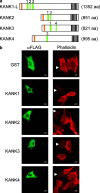Kank proteins: structure, functions and diseases
- PMID: 19554261
- PMCID: PMC11115667
- DOI: 10.1007/s00018-009-0038-y
Kank proteins: structure, functions and diseases
Abstract
The Kank family of proteins, Kank1-Kank4, are characterized by their unique structure, coiled-coil motifs in the N-terminal region, and ankyrin-repeats in the C-terminal region, with an additional motif, the KN motif, at the N-terminus. Kank1 was obtained by positional cloning of a tumor suppressor gene in renal cell carcinoma, while the other members were found by homology search. The family is involved in the regulation of actin polymerization and cell motility through signaling pathways containing PI3K/Akt and/or unidentified modulators/effectors. Their relationship to diseases such as cancer, and to neuronal and developmental disorders, will be an important subject of future study.
Figures




Similar articles
-
Structural basis for the recognition of kinesin family member 21A (KIF21A) by the ankyrin domains of KANK1 and KANK2 proteins.J Biol Chem. 2018 Jan 12;293(2):557-566. doi: 10.1074/jbc.M117.817494. Epub 2017 Nov 28. J Biol Chem. 2018. PMID: 29183992 Free PMC article.
-
Kank proteins: a new family of ankyrin-repeat domain-containing proteins.Biochim Biophys Acta. 2008 Feb;1780(2):128-33. doi: 10.1016/j.bbagen.2007.09.017. Epub 2007 Oct 4. Biochim Biophys Acta. 2008. PMID: 17996375
-
Structural analyses of key features in the KANK1·KIF21A complex yield mechanistic insights into the cross-talk between microtubules and the cell cortex.J Biol Chem. 2018 Jan 5;293(1):215-225. doi: 10.1074/jbc.M117.816017. Epub 2017 Nov 20. J Biol Chem. 2018. PMID: 29158259 Free PMC article.
-
KANK family proteins in cancer.Int J Biochem Cell Biol. 2021 Feb;131:105903. doi: 10.1016/j.biocel.2020.105903. Epub 2020 Dec 10. Int J Biochem Cell Biol. 2021. PMID: 33309958 Review.
-
The ING family tumor suppressors: from structure to function.Cell Mol Life Sci. 2011 Jan;68(1):45-54. doi: 10.1007/s00018-010-0509-1. Epub 2010 Aug 29. Cell Mol Life Sci. 2011. PMID: 20803232 Free PMC article. Review.
Cited by
-
Molecular Mechanisms of Fuchs and Congenital Hereditary Endothelial Corneal Dystrophies.Rev Physiol Biochem Pharmacol. 2020;178:41-81. doi: 10.1007/112_2020_39. Rev Physiol Biochem Pharmacol. 2020. PMID: 32789790 Review.
-
Identification of susceptibility gene mutations associated with the pathogenesis of familial nonmedullary thyroid cancer.Mol Genet Genomic Med. 2019 Dec;7(12):e1015. doi: 10.1002/mgg3.1015. Epub 2019 Oct 22. Mol Genet Genomic Med. 2019. PMID: 31642198 Free PMC article.
-
Prognostic significance of KN motif and ankyrin repeat domains 1 (KANK1) in invasive breast cancer.Breast Cancer Res Treat. 2020 Jan;179(2):349-357. doi: 10.1007/s10549-019-05466-8. Epub 2019 Nov 2. Breast Cancer Res Treat. 2020. PMID: 31679074 Free PMC article.
-
Genome-wide association study identifies three novel loci in Fuchs endothelial corneal dystrophy.Nat Commun. 2017 Mar 30;8:14898. doi: 10.1038/ncomms14898. Nat Commun. 2017. PMID: 28358029 Free PMC article.
-
Structural basis for the recognition of kinesin family member 21A (KIF21A) by the ankyrin domains of KANK1 and KANK2 proteins.J Biol Chem. 2018 Jan 12;293(2):557-566. doi: 10.1074/jbc.M117.817494. Epub 2017 Nov 28. J Biol Chem. 2018. PMID: 29183992 Free PMC article.
References
-
- Zhu Y, Kakinuma N, Wang Y, Kiyama R. Kank proteins: a new family of ankyrin-repeat domain-containing proteins. Biochim Biophys Acta. 2008;1780:128–133. - PubMed
-
- Rodley P, Hatano N, Nishikawa NS, Roy BC, Sarkar S, Kiyama R. A differential genomic cloning method for cancer study: an outline and applications. Recent Res Dev Mol Biol. 2003;1:13–27.
Publication types
MeSH terms
Substances
LinkOut - more resources
Full Text Sources

